Newsroom > News Release
UC San Diego Experts Calculate How Much Information Americans Consume
Computer Games and TV Account for Bulk of Information Consumed in 2008
San Diego, December 9, 2009 -- U.S. households consumed approximately 3.6 zettabytes of information in 2008, according to the "How Much Information? 2009 Report on American Consumers," released today by the University of California, San Diego. One zettabyte is 1,000,000,000 trillion bytes, and total bytes consumed last year were the equivalent of the information in thick paperback novels stacked seven feet high over the entire United States, including Alaska.
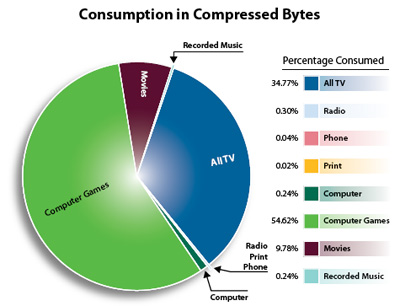 |
| Computer games surpassed even TV in terms of bytes consumed by Americans (outside the workplace) in 2008. [All graphics in this article are from How Much Information? 2009 Report on American Consumers.] |
|
The How Much Information? project is creating a census of the world’s information in 2008. The study measured information consumed by U.S. consumers in and outside the home for non-work related reasons, and included the gamut of information sources, including going to the movies, listening to the radio, talking on the cell phone, playing video games, surfing the Internet, and reading the newspaper, among other things.
“This report is a snapshot of what the information revolution means to the average American on an average day, who consumes 34 gigabytes and 100,000 words of information,” said report author Roger Bohn, Director of the Global Information Industry Center at UC San Diego’s School of International Relations and Pacific Studies. “The total volume of 3.6 zettabytes consumed last year is much larger than previous studies have reported, partly because they measured different views of information, such as information creation rather than consumption. Also, nobody had looked at the role of computer games, which generate a staggering number of bytes.”
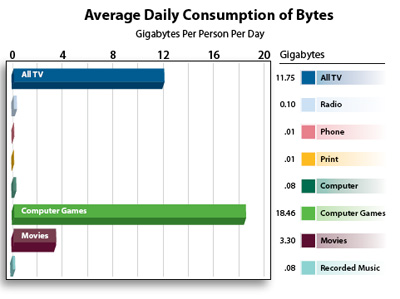 |
| Americans consumed an average per person per day of more than 18 gigabytes of information playing computer and video games -- more than all other sources of information combined. |
|
The new report estimates that between 1980 and 2008, bytes consumed increased 350 percent, for an average annual growth rate of 5.4 percent. According to the report, the average American’s information consumption of 34 gigabytes a day is the equivalent of about one fifth of a notebook computer’s hard drive, depending on the model.
Hourly statistics confirm that a large chunk of the average American’s day is spent watching television. The new report estimates that on average 41 percent of information time is watching TV (including DVDs, recorded TV and real-time watching). American consumers watched 36 million hours of television on mobile devices each month – a number that, while expected to grow, is a fraction of the hours spent watching television at home.
Based on bytes alone, however, computer games are the biggest information source totaling 18.5 gigabytes per day for the average American consumer, or about 67 percent of all bytes consumed. Approximately 80 percent of the population plays some kind of computer game, including casual games such as Bookworm, Tetris and social networking games.
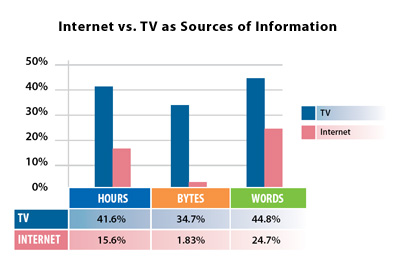 |
| Despite the rise of the Internet, TV continues to be the more dominant source of information, especially when comparing consumption statistics based on bytes. However, Internet outpaces TV in two-way communication. |
|
“Games are almost universal, but most of the gaming bytes come from graphically intensive games on high-powered computers and consoles, which have the equivalent of special-purpose supercomputers from five years ago,” said Bohn. “Games today generate their bytes inside the home, rather than having to transmit them over cables into the house, but gaming is increasingly moving online.”
Americans spent 16 percent of their information hours using the Internet (second only to TV’s 41 percent). With the proliferation of email, instant messaging and social networking, the Internet today dominates two-way communications, with more than 79 percent of those bytes every day.
Despite rapid growth, consumption of new media such as YouTube videos, text messaging or games on smartphones is still outpaced by traditional media.
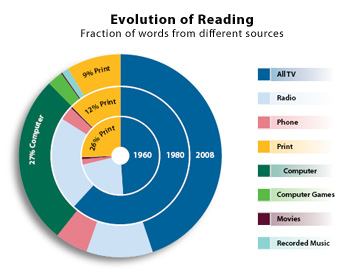 |
| Comparing the volume of words consumed by Americans (outside the workplace), the share of print media dropped sharply from 26 percent in 1960 to barely 9 percent in 2008. And since the personal-computer revolution began in earnest in 1981, computers as a source of information rocketed to 27 percent of total words consumed last year by U.S. households. |
|
“There are several hundred million TV sets in the U.S. , and depending on whom you ask, about 50 million smartphones,” explained report co-author James Short, research director of the Global Information Industry Center . “And new media devices are increasingly
personal devices – mobile phones, Kindles and handheld gaming devices – with small screens and relatively low resolution, limiting the number of bytes consumed.”
Looking to the future, the report’s authors point to current patterns of information consumption that will change the information landscape by 2015. In addition to the expected widespread use of HDTV, mobile television and video over the Internet have the potential to revolutionize where American consumers receive their visual information.
According to the study, the 3.6 zettabytes of total information used by Americans in their homes far exceeds storage or transmission capacity. For example, the total is roughly 20 times more than what can be stored at one time on all the hard drives in the world. Less than two percent of the total information was transmitted over the Internet.
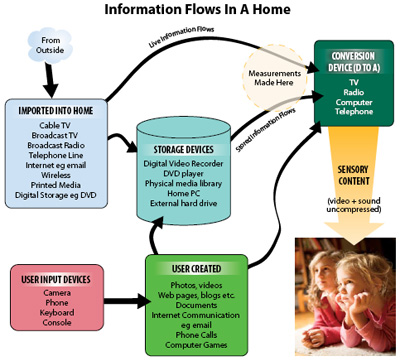 |
|
(above) Information flows in the home. (below) Quotes from some of the industry sponsors of UC San Diego's 'How Much Information?' research program:
AT&T
"The study's findings are consistent with what we've been seeing at AT&T: Americans have a voracious appetite for information, and seek to access more and more of it online," said Richard Clarke, Assistant Vice President of Public Policy, AT&T. "Over the past three years, we've experienced a 5,000 percent increase in wireless data traffic and a several hundred percent increase in wireline data traffic. We're working daily to expand the capacity of these networks to ensure that our consumers get what they want: information that's available anytime, anywhere and on any device."
Cisco Systems
"The HMI study offers important insights on the tremendous volume of digital content that the U.S. is generating and consuming on a daily basis," said Thomas Barnett, senior manager, Service Provider Marketing, Cisco. "This data also suggests the increasing value and role of the network in many aspects of our personal and business activities. The content consumption rates provided by the HMI study offer a consumer perspective that is consistent with the significant network growth rates that we are projecting within our own Cisco Visual Networking Index research."
IBM
"IBM welcomes this study to validate and quantify that information consumed by both businesses and consumers continues to rise dramatically," said Barry Rudolph, IBM vice president, System Storage. "Organizations are turning to IBM to help them develop smart solutions to collect, analyze, and manage that information in a world that is increasingly instrumented, interconnected and intelligent."
LSI
"The HMI research, including the upcoming report on worldwide enterprises, provide the industry with valuable insight into current and future patterns of information creation, movement and consumption," said Stan Skelton, vice president of Strategic Planning and Advanced Development, LSI Corporation. "Our sponsorship and participation in collaborative research projects like the HMI study are key to developing leading-edge storage and networking technologies that will meet next-generation customer requirements."
Seagate Technology
"As shown in the How Much Information? 2009 Report on American Consumers, Americans consumed record amounts of data and information," said Jeff Burke, Executive Director Market & Competitive Intelligence at Seagate Technology. "This study helps further the industry's understanding of the continuing boom in digital content creation and the amount of data stored across devices of all kinds."
|
|
"What is clear is that we consume orders of magnitude more information than can be stored on hard drives or transmitted over today's Internet," said Internet pioneer Larry Smarr, Director of the California Institute for Telecommunications and Information Technology, a partnership of UC San Diego and UC Irvine. "Even small changes in how Americans consume information would have serious implications for network planners and require large-scale investments."
To allow comparisons with earlier studies, the UC San Diego report’s authors devised mathematical formulas to convert all information statistics into words, bytes and the number of hours spent consuming information.
This initial report focuses on the U.S. consumer sector (both inside and outside the home, including use of cell phones and movie-watching). Future reports will focus on information in the U.S. workplace, in other regions, and different types of information (such as machine-to-machine data that is analyzed automatically and may never be seen by human eyes).
The report, “How Much Information? 2009 Report on American Consumers”, is available online and can be downloaded in PDF format at http://hmi.ucsd.edu/howmuchinfo.php. A quote sheet is available on request to dramsey@ucsd.edu.
###
About How Much Information?
The HMI? project is a research consortium led by the University of California , San Diego . Funding for the project comes from industry sponsors AT&T, Cisco Systems, IBM, Intel, LSI, Oracle and Seagate Technology, with early support from the Alfred P. Sloan Foundation.
Related Links
How Much Information? 2009 Report on American Consumers
How Much Information? Project
UC San Diego School of International Relations and Pacific Studies
Calit2
Media Contacts
Doug Ramsey, 858-822-5825, dramsey@ucsd.edu, or Rex Graham, 858-534-5952, ragraham@ucsd.edu





